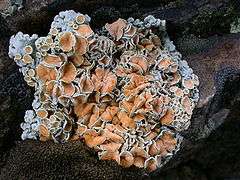List of lichens of Montana

There are at least 41 species of Lichens, Ascomycota known to exist in Montana.[1] The Montana Natural Heritage Program has identified a number of lichen species as Species of Concern.[2]
The Ascomycota are a Division/Phylum of the kingdom Fungi, and subkingdom Dikarya. Its members are commonly known as the sac fungi. They are the largest phylum of Fungi, with over 64,000 species.[3] The defining feature of this fungal group is the "ascus" (from Greek: ἀσκός (askos), meaning "sac" or "wineskin"), a microscopic sexual structure in which nonmotile spores, called ascospores, are formed. However, some species of the Ascomycota are asexual, meaning that they do not have a sexual cycle and thus do not form asci or ascospores. Previously placed in the Deuteromycota along with asexual species from other fungal taxa, asexual (or anamorphic) ascomycetes are now identified and classified based on morphological or physiological similarities to ascus-bearing taxa, and by phylogenetic analyses of DNA sequences.[4][5]
- Arctomiaceae [6]
- Delicate arctomia lichen, Arctomia delicatula
- Brigantiaeaceae [7]
- Brick-spored firedot lichen, Brigantiaea praetermissa
- Cladoniaceae [8]
- Thorn cladonia lichen, Cladonia uncialis
- Wooden soldiers lichen, Cladonia botrytes
- Collemataceae [9]
- Jelly lichen, Collema curtisporum
- Coniocybaceae [10]
- Collared glass whiskers lichen, Sclerophora amabilis
- Hymeneliaceae [11]
- Vagrant aspicilia lichen, Aspicilia fruticulosa
- Lecanoraceae [12]
- Wanderlust lichen, Rhizoplaca haydenii
- Lobariaceae [13]
- Cabbage lungwort lichen, Lobaria linita
- Gray lungwort lichen, Lobaria hallii
- Netted specklebelly lichen, Pseudocyphellaria anomala
- Textured lungwort lichen, Lobaria scrobiculata
- Thorn lichen, Dendriscocaulon umhausense
- Pannariaceae [14]
- Lead lichen, Parmeliella triptophylla
- Parmeliaceae [15]
- Camouflage lichen, Melanelia commixta
- Chestnut wrinkle-lichen, Cetraria sepincola
- Foxtail lichen, Nodobryoria subdivergens
- Frosted finger lichen, Dactylina ramulosa
- Mountain oakmoss lichen, Evernia divaricata
- Northern camouflage lichen, Melanelia septentrionalis
- Ribbon rag lichen, Platismatia stenophylla
- Ring lichen, Arctoparmelia subcentrifuga
- Shield lichen, Parmelia fraudans
- Tattered rag lichen, Platismatia herrei
- Peltigeraceae [16]
- Chocolate chip lichen, Solorina bispora
- Chocolate chip lichen, Solorina octospora
- Fringed chocolate chip lichen, Solorina spongiosa
- Fringed pelt lichen, Peltigera pacifica
- Waterfan lichen, Peltigera hydrothyria
- Pertusariaceae [17]
- Wart lichen, Pertusaria diluta
- Physciaceae [18]
- Shadow lichen, Phaeophyscia kairamoi
- Psoraceae [19]
- Scale lichen, Psora rubiformis
- Ramalinaceae [20]
- Hooded ramalina lichen, Ramalina obtusata
- Powdery twig lichen, Ramalina pollinaria
- Slit-rimmed ramalina lichen, Ramalina subleptocarpha
- Sphaerophoraceae [21]
- Coral lichen, Sphaerophorus tuckermanii
- Stereocaulaceae [22]
- Easter lichen, Stereocaulon paschale
- Umbilicariaceae [23]
- Rock tripe lichen, Umbilicaria havaasii
- Rock tripe lichen, Umbilicaria hirsuta
- Verrucariaceae [24]
- Elf-ear lichen, Normandina pulchella
- Speck lichen, Verrucaria kootenaica
Further reading
- Rydberg, Per Axel (1900). Catalogue of the flora of Montana and the Yellowstone National Park (PDF). New York: New York Botanical Garden.
- Bovey, Robin B.; Marsh, Janet E.; Vitt, Dale A. (2007). Mosses Lichens & Ferns of Northwest North America. Auburn, WA: Lone Pine Publishing. ISBN 1-55105-569-4.
- Harris, W.P.; Harris, C.W. (1904). Lichens and Mosses of Montana, a list based on material collected during the summer of 1901, with additions. Missoula, MT: University of Montana.
- McCune, B.; Geiser, L. (2009). Macrolichens of the Pacific Northwest: Second Edition, Revised and Expanded. Corvallis, OR: Oregon State University Press.
See also
Notes
- ↑ "Montana Field Guide-Sac Fungi". Montana Department of Fish, Wildlife and Parks. Retrieved 2010-12-07.
- ↑ Species of Concern are native taxa that are at-risk due to declining population trends, threats to their habitats, restricted distribution, and/or other factors. Designation as a Montana Species of Concern or Potential Species of Concern is based on the Montana Status Rank, and is not a statutory or regulatory classification. Rather, these designations provide information that helps resource managers make proactive decisions regarding species conservation and data collection priorities. See the latest Species of Concern Reports for more detailed explanations and assessment criteria. "Montana Field Guide-Species of Concern". Retrieved 2010-12-07.
- ↑ Kirk et al., p. 55.
- ↑ Lutzoni F, et al. (2004). "Assembling the fungal tree of life: progress, classification, and evolution of subcellular traits". American Journal of Botany. 91: 1446–80. doi:10.3732/ajb.91.10.1446. PMID 21652303.
- ↑ James TY, et al. (2006). "Reconstructing the early evolution of Fungi using a six-gene phylogeny". Nature. 443 (7113): 818–22. doi:10.1038/nature05110. PMID 17051209.
- ↑ "Montana Field Guide- Arctomiaceae". Montana Department of Fish, Wildlife and Parks. Retrieved 2010-12-08.
- ↑ "Montana Field Guide-Brigantiaceae". Montana Department of Fish, Wildlife and Parks. Retrieved 2010-12-08.
- ↑ "Montana Field Guide- Cladoniaceae". Montana Department of Fish, Wildlife and Parks. Retrieved 2010-12-08.
- ↑ "Montana Field Guide- Collemataceae". Montana Department of Fish, Wildlife and Parks. Retrieved 2010-12-08.
- ↑ "Montana Field Guide- Coniocybaceae". Montana Department of Fish, Wildlife and Parks. Retrieved 2010-12-08.
- ↑ "Montana Field Guide-Hymeneliaceae". Montana Department of Fish, Wildlife and Parks. Retrieved 2010-12-08.
- ↑ "Montana Field Guide-Lecanoraceae". Montana Department of Fish, Wildlife and Parks. Retrieved 2010-12-08.
- ↑ "Montana Field Guide-Lobariaceae". Montana Department of Fish, Wildlife and Parks. Retrieved 2010-12-08.
- ↑ "Montana Field Guide- Pannariaceae". Montana Department of Fish, Wildlife and Parks. Retrieved 2010-12-08.
- ↑ "Montana Field Guide- Parmeliaceae". Montana Department of Fish, Wildlife and Parks. Retrieved 2010-12-08.
- ↑ "Montana Field Guide-Parmeliaceae". Montana Department of Fish, Wildlife and Parks. Retrieved 2010-12-08.
- ↑ "Montana Field Guide- Pertusariaceae". Montana Department of Fish, Wildlife and Parks. Retrieved 2010-12-08.
- ↑ "Montana Field Guide-Physciaceae". Montana Department of Fish, Wildlife and Parks. Retrieved 2010-12-08.
- ↑ "Montana Field Guide-Psoraceae". Montana Department of Fish, Wildlife and Parks. Retrieved 2010-12-08.
- ↑ "Montana Field Guide-Ramalinaceae". Montana Department of Fish, Wildlife and Parks. Retrieved 2010-12-08.
- ↑ "Montana Field Guide-Sphaerophoraceae". Montana Department of Fish, Wildlife and Parks. Retrieved 2010-12-08.
- ↑ "Montana Field Guide-Stereocaulaceae". Montana Department of Fish, Wildlife and Parks. Retrieved 2010-12-08.
- ↑ "Montana Field Guide- Umbilicariaceae". Montana Department of Fish, Wildlife and Parks. Retrieved 2010-12-08.
- ↑ "Montana Field Guide- Verrucariaceae". Montana Department of Fish, Wildlife and Parks. Retrieved 2010-12-08.
